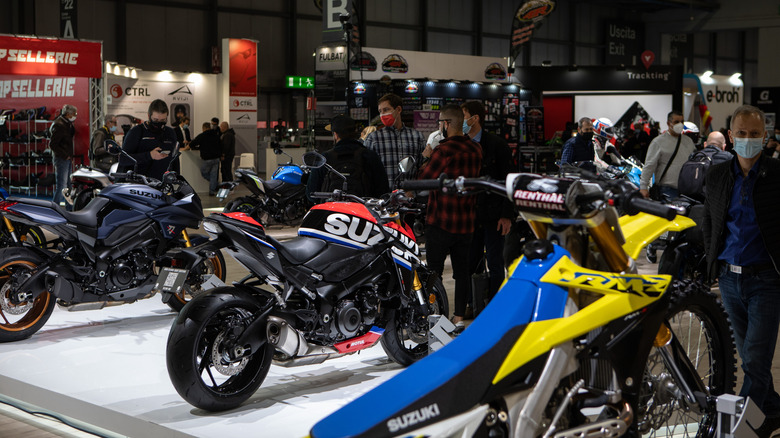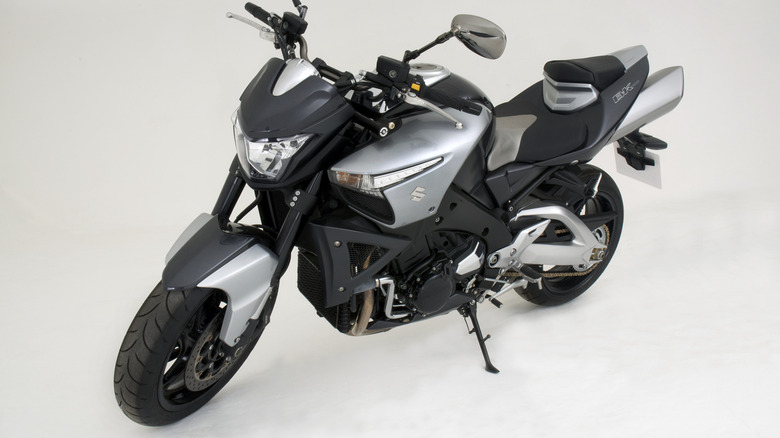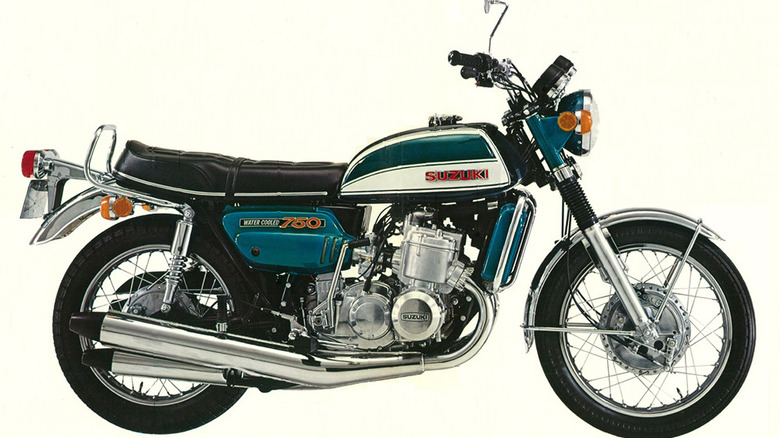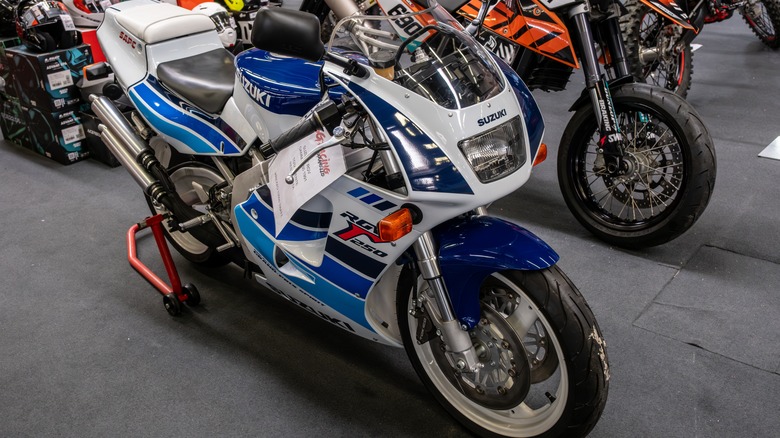5 Of The Coolest-Looking Motorcycles Ever Made By Suzuki
Motorcycles are remembered for different reasons; some for their innovative engineering, others for their dazzling performances. But every now and then, some machines make their mark in history for just looking cool. Unsurprisingly, Suzuki has bikes to showcase all three, but we can all agree that nobody outshines Suzuki in making motorcycles that are stylish in a classic manner. Futuristic sportbikes or chrome-dripping two-stroke screamers? Suzuki has it all, all thanks to its design team that's always up to push the envelope.
Well, this isn't a ranking of the fastest or the most expensive bikes by Suzuki. It's more of homage to a few of many motorcycles that drew attention by their visual presence — you know, the kind that are on posters for kids to put on their walls or makes rivals anxious and collectors hungry. The beautiful part is that every one of them has a backstory, either a design gamble that paid off, new tech encased in unique styling, or just something aimed at evoking fond memories at bike events.
And we're not talking about pretty faces on a surface level. Each of these bikes, in one way or another, pushed design trends forward. Some pioneered something radical, while others simply perfected a classic shape. Some are big names in racing, others are more experimental. But despite the differences in their spec sheets and quarter-mile times, they've all got one thing in common — aura.
Suzuki B-King
When you glance at the 2007 Suzuki B-King, you see a boss fight on wheels more than a motorcycle. It was (and still is) the kind of machine you could park next to anything — a Ducati, a Cybertruck, or even a SpaceX Starship — and win the intimidation game. With its enormous dual exhausts, cyberpunk silhouette, and bulky tank shoulders, some may argue that the B-King looks dangerous, for lack of a better word. Beneath its sculpted armor, the bike hid a 1340cc inline-four engine, which Suzuki borrowed from its then-record-breaking superbike, and tuned slightly softer for the street but still capable of sending the bike into absurd territory.
Despite being first unveiled in 2001 as a supercharged concept, the production B-King dropped the blower but retained all the bravado. Its angular bodywork, raw stance, and near-170 horsepower made it one of the most blatantly overbuilt naked bikes of its time. According to testers, the throttle is addictive and heavy.
Sure, it was heavy and somewhat impractical, which scared off casual riders, but that's precisely why it became a cult classic. The whole intent behind it wasn't to win over everyone. Instead, it was designed for riders who wanted to feel a bit unhinged every time they cranked it up. And after a brief run of production and a cult following later, it still stands as Suzuki's iconic designs, combining drama and menace in equal measure.
Suzuki Katana
When Suzuki debuted the Katana in 1981, it wasn't just rolling out another sportbike for the sake of it, but rather redefining what motorcycles could look like. The bike was designed in Germany by Hans Muth and his Target Design team, in a bid to challenge the supremacy of European styling. Boasting sharp lines, an integrated cockpit, a hunched-forward posture, and a futuristic "flyline" profile, it looked like a predator ready to strike. Named after Katana — the sleek, curved Japanese sword wielded by the samurai, it's safe to say the bike lived up to the moniker.
At first, not everyone loved the design. Some thought it appeared too aggressive and unorthodox, but that was the point. Suzuki wanted something that stood out from the era's round-headlight UJMs. Its headlight, tank, and seat all flowed together in a single motion, inspiring a new design philosophy that countless bikes adopted in the years to come.
It wasn't just about looks as beneath that angular fairing sat a 1,074-cc inline-four. Period coverage from Hot Rod Magazine described the U.S.-spec Suzuki Katana as "geared for 141 mph," or about 227 km/h, making it one of the fasted production motorcycles available at the time. But its revolution in style nearly overshadowed its speed. Decades later, the Katana is still seen as one of Suzuki's influential designs and a symbol capturing a moment when Suzuki proved that design could be bold, confrontational, and still look cool at the same time.
Suzuki RE5 Wankel Rotary
The Suzuki RE5 (1974-1976) remains one of the most audacious motorcycles ever built. Suzuki made a significant investment in the Wankel rotary engine, a technology that was hailed for its smoothness but beset by cost and complexity, while other manufacturers experimented cautiously. The bike's liquid-cooled rotary was revolutionary, to say the least, but its styling, which was designed by Giorgetto Guigiaro, a renowned Italian designer, was what made it stand out.
Guigiaro — who also designed the DeLorean DMC-12 and the original Volkswagen Golf — gave the RE5 a simple, almost futuristic look. The bike's unique cylindrical instrument cluster and matching taillight made it recognizable at a glance, while rounded corners eased its bulk. Even the exhaust tips were redesigned to look clean and tubular, highlighting the rotary's unusual character.
Compared to the vibration-heavy four-strokes of its time, the RE5 was strangely smooth on the road — almost alien. Riders' opinions were split, with some loving every bit of the silky, turbine-like delivery, and others finding it too sterile. Even so, few disputed the bike's striking appearance, which looked like a concept machine that finally made it into production. Sales were low, but over time, its cool factor has grown. Collectors now value it as a two-wheeled Giugiaro design experiment, in addition to a rotary oddity. While it may not have had the desired impact on the industry, like say the Katana, it still solidified Suzuki's reputation for audacity.
Suzuki GT750 Water Buffalo
If you were a motorhead in the 1970s and wanted something that screamed presence, then the Suzuki GT750 was the bike for you. It was nicknamed "Water Buffalo" in the U.S. and "Kettle" in the U.K. and was the first Japanese 750cc liquid-cooled production motorcycle. Rolling out of production from 1971 to 1977, it featured a three-cylinder two-stroke, chunky proportions, technological muscle, and clever stylistic touches that made it stand apart.
Its broad seat and long fuel tank created a strong, muscular profile that highlighted stability and strength. It had symmetry and personality, thanks to two exhausts, one on each side and a third pipe split underneath. And in a time when conservative color schemes predominated, the use of vibrant colors like metallic purples, greens, and blues made it pop, adding to its unique style.
In contrast to the Honda CB750 and Kawasaki H2, which were deemed worthy opponents at the time, the GT750 looked more like a road-dominating cruiser than a racer. That doesn't mean it was a slouch; in fact, far from it, courtesy of its liquid cooling, which improved sustained performance. Most old-timer bikers remember it as big, comfortable, and whether you loved it or hated it, it was almost impossible to ignore. Today, restored GT750 Water Buffalos still draw attention at vintage bike shows, proving that its blend of bulk, style, and innovation has evolved into classic cool, which some motorcycle enthusiasts and collectors still cherish.
Suzuki RGV250
In the late 1980s and early 1990s, the Suzuki RGV250 was the real deal for riders who wanted to experience a slice of the Grand Prix magic. This two-stroke sportbike, produced from 1988 to 1998, drew direct inspiration from Suzuki's 250cc GP race machines, you'd have thought it was part of the lot. But unlike the GP race models, the RGV250 was street-legal, compact, sharp, and brimming with aggression, enough to make every owner feel like they'd walk into WorldSBK or Moto GP and stand a chance.
The bike weighed slightly above 305 pounds dry and boasted a twin-spar aluminum frame, which not only kept the weight down, but also reinforced its purposeful, high-performance stance. Add bright race-inspired color schemes — often Suzuki's iconic blue and yellow — into the mix, and its aura was simply unmatched.
With a roaring two-stroke V-twin producing roughly 60 horsepower at extremely high rpms, the performance was fierce for its size. However, it's safe to say the thrill was equally enhanced by the visuals. The bike always had a certain menace; a look that suggested agility and barely controlled mayhem, especially when lined up next to bulkier rivals like Honda's NSR250. With its fierce two-stroke performance and razor-sharp handling, the RGV250 became a cult classic in different regions, providing riders with an adrenaline-pumping experience unmatched by other 250s of the time and continues to be one of Suzuki's coolest-looking motorcycles ever.





